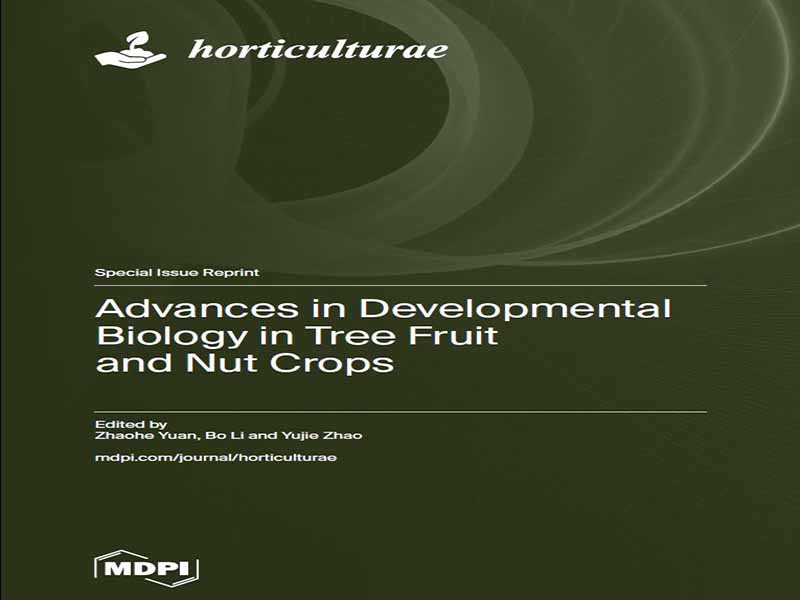- عنوان کتاب: Advances in Developmental Biology in Tree Fruit and Nut Crops
- نویسنده: Zhaohe Yuan, Bo Li, Yujie Zhao
- حوزه: زیست شناسی گیاهان
- سال انتشار: 2025
- تعداد صفحه: 258
- زبان اصلی: انگلیسی
- نوع فایل: pdf
- حجم فایل: 12.8 مگابایت
محصولات میوه و آجیل درختی نه تنها به دلیل اهمیت غذایی و اقتصادی، بلکه به دلیل پیچیدگی فرآیندهای رشدی خود، بخش حیاتی کشاورزی جهانی را تشکیل میدهند. این محصولات اغلب شبکههای تنظیمی پیچیدهای را نشان میدهند که گلدهی، تشکیل میوه، رشد میوه، رسیدن و پیری را کنترل میکنند، که همه آنها به طور قابل توجهی تحت تأثیر شرایط محیطی، آرایش ژنتیکی و شیوههای باغبانی قرار دارند [1]. در طول دو دهه گذشته، تحقیقات گسترده نشان داده است که زیستشناسی رشد محصولات میوه و آجیل درختی توسط یک تعامل چند لایه از سیگنالینگ هورمونی، تنظیم رونویسی، اصلاح اپی ژنتیکی و برنامهریزی مجدد متابولیک شکل میگیرد [2]. پیشرفت در ابزارهای مولکولی و رویکردهای “omics” با توان عملیاتی بالا، توانایی ما را در رمزگشایی این شبکههای پیچیده تسریع کرده و در نتیجه مرزهای جدیدی را در بهبود کیفیت میوه، تحمل به تنش و مدیریت پایدار باغ گشوده است [3]. با وجود این گامهای قابل توجه، شکافهای بسیاری باقی مانده است. یکی از این شکافها مربوط به تعامل بین هموستاز هورمون و عوامل رونویسی کنترل کننده رشد میوه است. فیتوهورمونهای کلاسیک – مانند اکسینها، جیبرلینها، سیتوکینینها، اسید آبسیزیک و اتیلن – به عنوان تنظیمکنندههای اصلی رشد و رسیدن میوه به خوبی شناخته شدهاند [4]. با این حال، دستههای جدیدی از تنظیمکنندهها، از جمله میکرو RNAها و RNAهای غیرکدکننده طولانی، به عنوان تنظیمکنندههایی که تأثیرات عمیقی بر بیان ژن و مسیرهای متابولیکی در طول پیشرفت رشد و پیری میوه دارند، شناسایی شدهاند [5]. نقش این RNAهای غیرکدکننده در محصولات میوه چندساله کمتر از گونههای یکساله مانند گوجهفرنگی یا آرابیدوپسیس مشخص شده است، که نشان دهنده نیاز مبرم به مطالعات عملکردی جامعتر در محصولات میوه درختی و آجیل است [6]. علاوه بر تنظیم هورمونی و رونویسی، رشد میوه به شدت تحت تأثیر متابولیسم کربوهیدرات، بازسازی دیواره سلولی و بیوسنتز متابولیتهای ثانویه قرار دارد. در دسترس بودن کربوهیدرات در میوه در حال رشد به روابط منبع-مخزن بستگی دارد که در طول فصل رشد پویا هستند. قدرت مخزن توسط فعالیت ناقلهای قند، اینورتازها و سایر آنزیمهایی که کربن را به میوه در حال رشد اختصاص میدهند، تعدیل میشود [7]. در همین حال، بیوسنتز رنگدانهها و متابولیتهای ثانویه – مانند آنتوسیانینها، فلاونولها و ترپنوئیدها – نقش کلیدی در کیفیت میوه ایفا میکند و بر رنگ، طعم و ارزش غذایی آن تأثیر میگذارد [8]. این ویژگیها برای پذیرش مصرفکننده و رقابت در بازار بسیار مهم هستند. برنامههای اصلاح نژادی مدرن به طور فزایندهای این ویژگیهای کیفی را هدف قرار میدهند و به دنبال ادغام نشانگرهای مولکولی برای قند، اسید و محتوای متابولیتهای ثانویه در خطوط تولید متعارف هستند [9]. با این حال، شبکههای ژنتیکی و بیوشیمیایی زیربنای این ویژگیها میتوانند در گونههای مختلف میوه و آجیل درختی به طور قابل توجهی متفاوت باشند و تلاشها برای انتقال دانش از سیستمهای مدل به منابع ژرمپلاسم متنوع را پیچیدهتر کنند [10]. تغییرات اقلیمی درک ما از زیستشناسی رشد در محصولات میوه و آجیل چند ساله را پیچیدهتر میکند. افزایش دما، تغییر الگوهای بارندگی و افزایش فراوانی رویدادهای شدید آب و هوایی، پایداری سیستمهای باغی در سراسر جهان را به چالش میکشد [1]. به عنوان مثال، تغییرات در تجمع سرمای زمستانی میتواند باعث اختلال در رهایی از خواب و زمان گلدهی شود و منجر به عدم تطابق بین گرده افشانها و دورههای شکوفهدهی شود و در نهایت بر تشکیل میوه تأثیر بگذارد. همزمان، تنشهای غیرزیستی مانند خشکسالی و شوری میتوانند به طور چشمگیری کارایی فتوسنتز را کاهش دهند، هموستاز هورمونی را تغییر دهند و رسیدن را تسریع یا به تأخیر بیندازند [2]. در نتیجه، نیاز به توسعه ارقام مقاوم به آب و هوا و شیوههای مدیریت باغبانی سازگار، هرگز تا این حد ضروری نبوده است. بنابراین، محققان تلاشهای خود را برای شناسایی ژنهای پاسخگو به تنش، بررسی مکانیسمهای تنظیمی آنها و گنجاندن این دانش در برنامههای اصلاح نژاد و پروتکلهای باغبانی تشدید میکنند [3]. در این چشمانداز به سرعت در حال تحول، کاربرد فناوریهای پیشرفته – از ویرایش ژن مبتنی بر CRISPR/Cas9 گرفته تا رونوشتبرداری تک سلولی – فرصتهای بیسابقهای را برای تشریح و دستکاری مسیرهای کلیدی رشد ایجاد کرده است [4]. محصولات میوه و آجیل درختی از نظر تاریخی در پذیرش چنین فناوریهایی از گیاهان یکساله عقب ماندهاند، که بخشی از آن به دلیل مراحل طولانی جوانی، اندازه بزرگ ژنوم و پلیپلوئیدی پیچیده در جنسهای خاص است [5]. با این حال، موفقیتهای اخیر در تغییر و ویرایش گونههای درختان میوه نشان میدهد که این شکاف در حال بسته شدن است. برای مثال، پیشرفتهای حاصل در پروتکلهای تراریختی با واسطه آگروباکتریوم و توسعه سیستمهای تراریختی مستقل از ژنوتیپ، امکانسنجی مطالعات ژنومیک عملکردی در محصولات میوه را به طور قابل توجهی بهبود بخشیده است [6]. علاوه بر این، این حوزه شاهد گسترش رویکردهای چند-اومیکس یکپارچه است. با ترکیب ژنومیک، ترانسکریپتومیک، پروتئومیک، متابولومیک و اپیژنومیک، محققان در حال ترسیم یک …
Tree fruit and nut crops constitute a vital component of global agriculture, not only by virtue of their nutritional and economic importance, but also because of the complexity of their developmental processes. These crops often exhibit intricate regulatory networks that govern flowering, fruit set, fruit expansion, ripening, and senescence, all of which are significantly influenced by environmental conditions, genetic makeup, and horticultural practices [1]. Over the last two decades, extensive research has revealed that the developmental biology of tree fruit and nut crops is shaped by a multilayered interplay of hormonal signaling, transcriptional regulation, epigenetic modification, and metabolic reprogramming [2]. Advances in molecular tools and high-throughput “omics” approaches have accelerated our ability to decipher these complex networks, thus opening new frontiers in fruit quality improvement, stress tolerance, and sustainable orchard management [3]. Despite these remarkable strides, many gaps remain. One such gap concerns the interplay between hormone homeostasis and the transcription factors controlling fruit development. Classical phytohormones—such as auxins, gibberellins, cytokinins, abscisic acid, and ethylene—are well established as central regulators of fruit development and ripening [4]. However, new classes of regulators, including microRNAs and long noncoding RNAs, have been identified as having profound influences on gene expression and metabolic pathways during the progression of fruit growth and senescence [5]. The role of these non-coding RNAs in perennial fruit crops is less well characterized than in annual species such as tomato or Arabidopsis, indicating a pressing need for more comprehensive functional studies in tree fruit and nut crops [6]. In addition to hormonal and transcriptional regulation, fruit development is strongly impacted by carbohydrate metabolism, cell wall remodeling, and secondary metabolite biosynthesis. Carbohydrate availability in the developing fruit depends on source–sink relationships, which are dynamic throughout the growing season. Sink strength is modulated by the activity of sugar transporters, invertases, and other enzymes that allocate carbon to the developing fruit [7]. Meanwhile, the biosynthesis of pigments and secondary metabolites—such as anthocyanins, flavonols, and terpenoids—plays a key role in fruit quality, influencing color, flavor, and nutritional value [8]. These traits are crucial for consumer acceptance and market competitiveness. Modern breeding programs increasingly target these quality attributes, seeking to integrate molecular markers for sugar, acid, and secondary metabolite content into conventional breeding pipelines [9]. However, the genetic and biochemical networks underlying these traits can vary significantly across different tree fruit and nut species, complicating efforts in translating knowledge from model systems to diverse germplasm resources [10]. Climate change further complicates our understanding of developmental biology in perennial fruit and nut crops. Rising temperatures, altered rainfall patterns, and the increased frequency of extreme weather events challenge the stability of orchard systems worldwide [1]. Changes in winter chill accumulation, for instance, can disrupt dormancy release and flowering times, leading to mismatches between pollinators and bloom periods, ultimately affecting fruit set. Concurrently, abiotic stresses such as drought and salinity can drastically reduce photosynthetic efficiency, alter hormonal homeostasis, and accelerate or delay ripening [2]. Consequently, the need to develop climate-resilient cultivars and adaptive orchard management practices has never been more urgent. Researchers are thus intensifying their efforts to identify stress-responsive genes, investigate their regulatory mechanisms, and incorporate this knowledge into breeding programs and horticultural protocols [3]. In this rapidly evolving landscape, the application of cutting-edge technologies— ranging from CRISPR/Cas9-based gene editing to single-cell transcriptomics—has opened up unprecedented opportunities for dissecting and manipulating key developmental pathways [4]. Tree fruit and nut crops have historically lagged behind annuals in adopting such technologies, partly due to their extended juvenile phases, large genome sizes, and complex polyploidy in certain genera [5]. Yet, recent successes in the transformation and editing of fruit tree species suggest that the gap is closing. For instance, breakthroughs in Agrobacterium-mediated transformation protocols and the development of genotypeindependent transformation systems have significantly improved the feasibility of functional genomics studies in fruit crops [6]. Furthermore, the field is witnessing an expansion of integrated multi-omics approaches. By combining genomics, transcriptomics, proteomics, metabolomics, and epigenomics, researchers are painting an increasingly comprehensive picture of how multiple layers of regulation converge to shape fruit and nut development [7]. In particular, integrative omics has proven instrumental in pinpointing candidate genes and pathways linked to traits of agronomic interest, such as fruit size, flavor, texture, and stress tolerance [8]. Once identified, these candidate genes can be validated through functional assays, thus expediting the process of varietal improvement.
این کتاب را میتوانید از لینک زیر بصورت رایگان دانلود کنید:
Download: Advances in Developmental Biology in Tree Fruit and Nut Crops



































نظرات کاربران